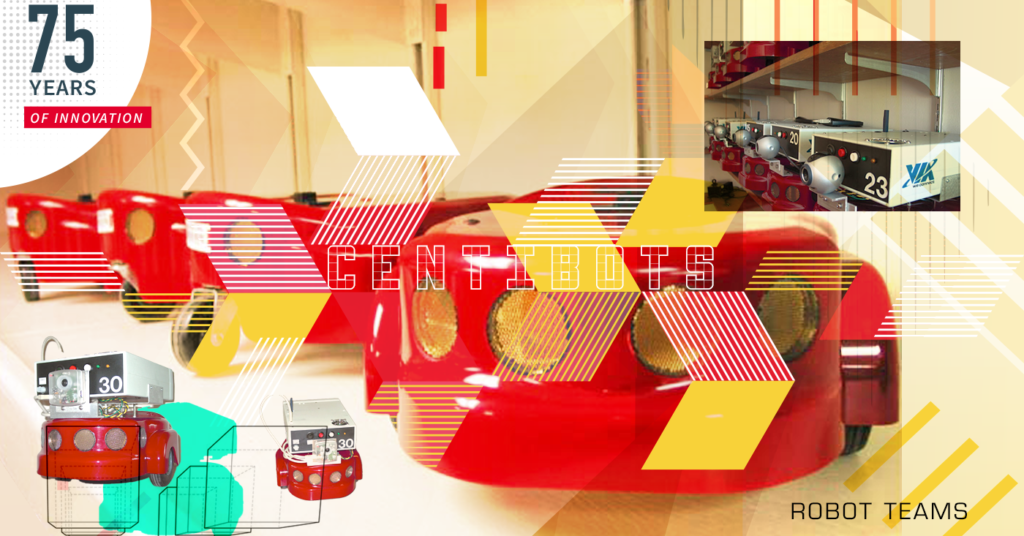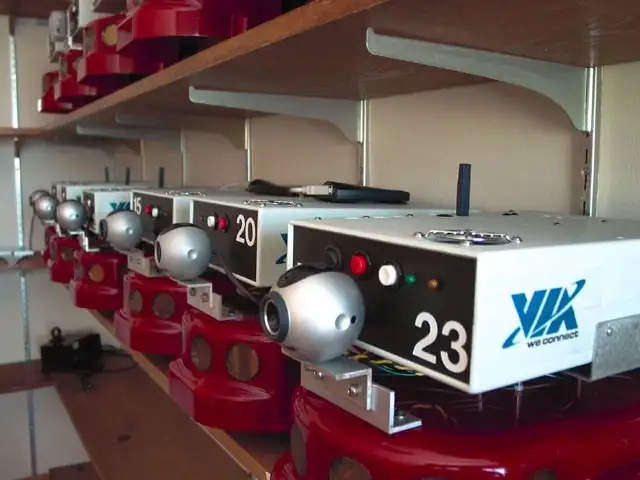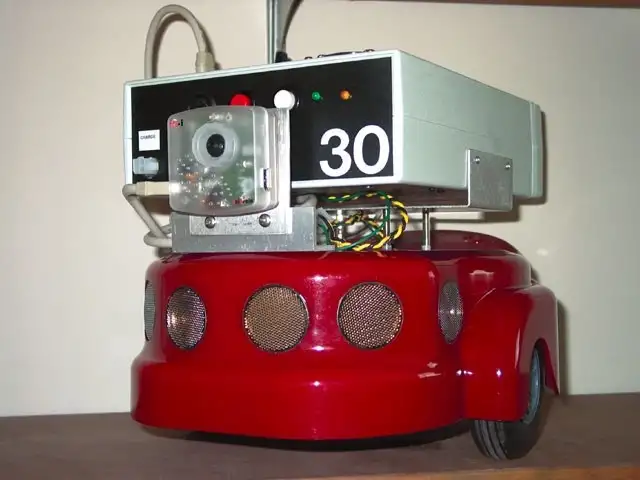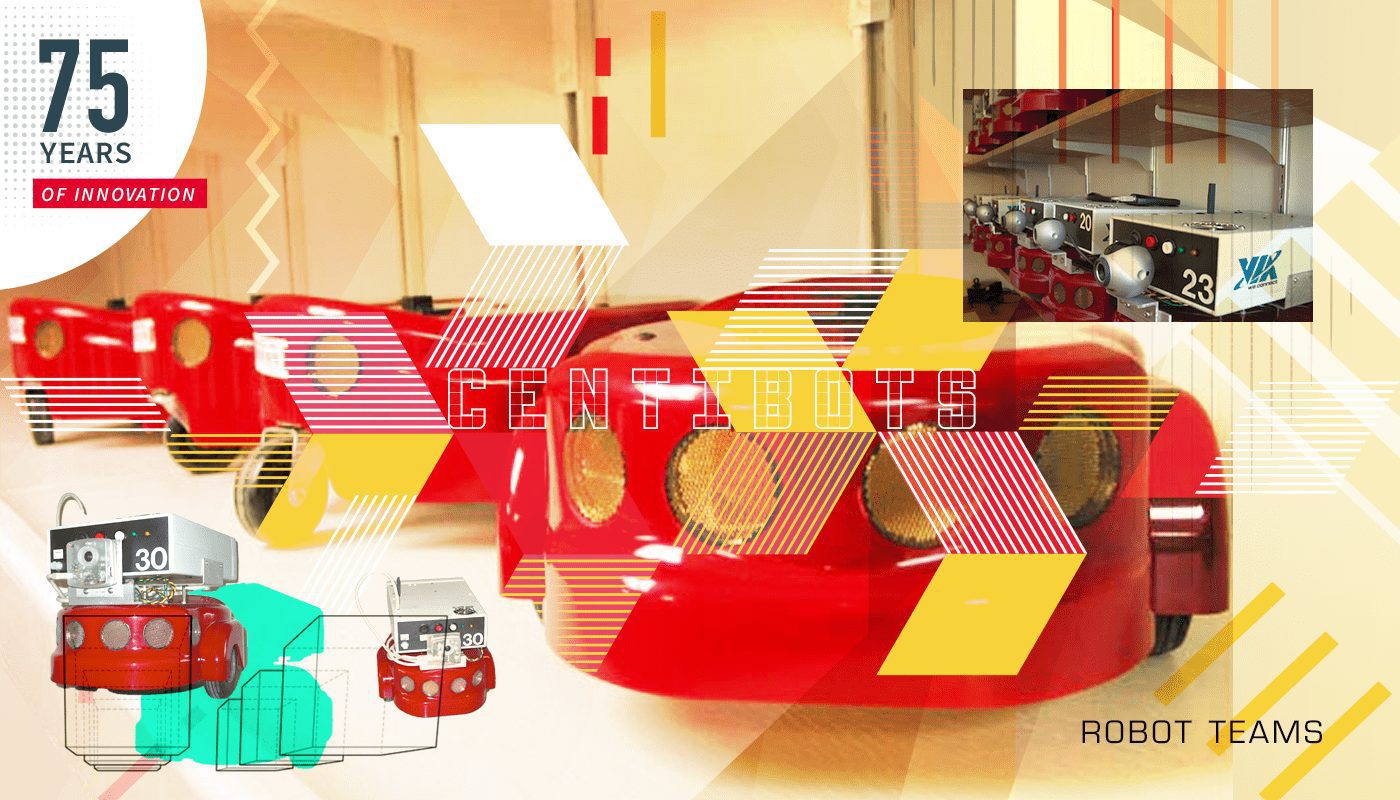The hive mind of robots
The 75 Years of Innovation series highlights the groundbreaking innovations spanning from SRI’s founding in 1946 to today. Each week, SRI will release an innovation, leading up to its 75th anniversary in November 2021.

“Impossible is a word that humans use far too often,” Seven of Nine part of the Borg’s hive mind in Star Trek.
Human beings and robots have a recent relationship and one which is continuously explored through innovation. In one of SRI International’s early inventions, a robot named Shakey entered the world. Shakey was the first robot to use Artificial Intelligence to help it navigate through rooms and robot life. Shakey is also the great, great, great grandparent of another SRI collaboration, the Centibots.
Centibots were born into a more mature robotic world than their forebears, one which demands robotic help to deal with specific issues; Centibots were designed to act like a collaboration (a ‘cobot’), a swarm, a hive of robots.
This is why Centibots were invented…
When Robots Collaborate: How Centibots Became a Swarm
When we think of a robot, we often think of an individual robotic unit like ‘Robbie the Robot’. A robot that is perhaps built to look like a human and do the kinds of jobs humans do in their everyday life. But if you distill a robot down to its basic meaning, of a system to perform tasks for humans, the idea of a collective of robots all working together can open up new opportunities. When we look at eusocial insects, for example, bees, we see a vast group of insects that work in collaboration to maintain a nest for an optimal reproductive environment. Swarms of robots can act in a similar manner, working together on a common goal.

Centibots are a collective of over 100 individual robot units. They were originally designed to work in an urban setting, for example, to do building surveillance. In their original remit, the Centibots were split into two collaborative teams, interacting to build up a picture of an area. The first team of Centibots (mapping robots called ‘Pioneers’) surveyed a chosen area, building and sharing a distributed map. The second team (tracking robots called ‘Amigobots’) were configured to look for a specific object within the mapped area; the tracking Centibots, sensing and tracking unwanted objects, like an intruder. The resulting data was shared among the group members/teams working as a command center: the result was a robotic surveillance network.
One of the key innovations of a robotic swarm, like Centibots, is that if a robot fails, another instantly takes its place with no human intervention. In this way, Centibots are autonomous but connected to each other.
The SRI International Centibots project was funded by the Defense Advanced Research Projects Agency (DARPA).
How the Centibots Swarmed
Centibots were an early experiment in a distributed robotic system; the goal at SRI was to advance the state-of-the-art in this discipline. Distributed robots are separate yet connected. Centibots use an ecosystem of technologies to create this robot collective. These technologies are designed to be cost-effective and simple within an individual unit — a true case of the whole being greater than the sum of the parts:
● The Pioneers contained laser rangefinders to detect obstacles, generate data, and subsequently map an area
● Amigobots were supplied with ultrasound sensors in a camera to detect objects that are not on the map created by the first robot team
● An ad hoc network allowed communications between robots
● The data was then shared via a command center
Having different classes of robot, such as mapping and tracking, requiring different technology components, helped to reduce costs.

Centibots used a number of techniques to place a robot in space at a given time. One is a similar system to the hidden Markov model (HMM) approach (also used by SRI in their natural language speech recognition system DECIPHER); this allows for robot localization based on probability distributions. As the robot moves around, the data is updated. Each robot position is in relation to the next robot in the team.
The Centibots project was also designed to look at human-robot interaction as well as robot-robot cooperation.
Robot Swarm to the Rescue!
Centibots, as individual robots, were designed to be simple and cost-effective. But when these robots came together, they made something very special. Robots that can communicate with each other, make decisions, and that require little human interaction can be used in dangerous and difficult situations and terrain. For example, the Centibots project was originally designed to explore the use of swarm robots in military situations. The autonomous decision making in the design of Centibots meant that they could be used in many situations where human decision-makers were not readily available or where it was too dangerous; this could include space missions as well as many commercial applications.
As the technology of distributed robotic system progresses, in part because of the work done by the robotics team at SRI, we are now seeing robot swarms used for commercial applications including agriculture and Micro Air Vehicles (MAVs).
Centibots, your great, great, great grandparent, Shakey, would be proud.
Resources
It Came, It Saw, It Shook up AI: “Shakey” the Robot: https://medium.com/dish/75-years-of-innovation-shakey-the-robot-385af2311ec8
SRI Centibots Project: http://www.ai.sri.com/centibots/
Video from 2016 discussing how Centibots work: https://www.youtube.com/watch?v=lsEBkLG2too&t=3776s
Centibots Mapping example from Washington University: https://www.cs.washington.edu/research/rse-lab/projects/centibots
SRI’s DECIPHER System, Cohen, M., et. al., Speech Research Program, SRI Int., February 1989: https://www.researchgate.net/publication/234810357
Swarm robot use in agriculture: https://www.agri-tech-e.co.uk/swarm-robotics-offer-precision-agriculture-at-plant-level/



